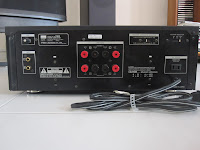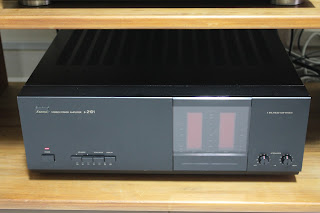 |
| Original |
I then used a small hacksaw and sand-paper to fashion the strip into a similar dimension Quad 33 Tape Adapter board. The entire job can be easily completed within an hour.
 |
| From top |
 |
| View of bottom |
Inserting the DIY Tape Adapter, it fit perfectly into the slot of my 2nd Quad 33 (which has been upgraded internally - need to reduce length of the board later)!
 |
| After insertion and Quad 33 in-use |
Powering up was proof of a job well done.
Reproduction was revealing, especially on bad recordings - does no favours for them! And vice-versa.
As the reproduction could be a little raw at times, I tried inserting small value non-EC caps into the signal path to smoothen it out. Hence I replace the bare jumpers with a 0.047uF Russian Paper-In-Oil (PIO) capacitor in the REPLAY pathway. Made the unit sound more or less like the original 33.
 |
| With Russian PIO(s) |
Then experimented with an old fashion Wima 0.33uF (original Quad value ... hmm) in-place of the PIO. The lows sound decent without the raw-ness but lack HF clearity. HF seem a little muddle. You can hear the HF details, as if they were being push into the background.
 |
| With older Wima(s) |
Next step was to insert a 2pF silver mica to the REPLAY pathway, in-parallel to the Wima. The silver mica(s) act as a tonal bass-pass. And after 30min or so, the unit sounds good again - without the raw-less-ness in the reproduction.
 |
| With Wima(s) and silver mica |
 |
| With 1uF added |
LF's are now decent (without overemphasis), and, the HF are realistic (aka natural) due to the clearity of the reproduction.
Source is the Audiolab 8000DAC and 8000CDM, pre is the 2nd Quad 33 (internally upgraded) and power via the 3rd Quad 303 (late model) driving my Meridian speakers. The interconnect cables between the CDP and the Quad 33 was fashion from phone cables (nothing fancy). Cables between the Quad(s) are factory issued. Speaker cables are the ones I have been using since discovering their hidden talent!
NOTE:
After inserting the DIY TAPE ADAPTER into the 33, upon powering-on the 33 - DO NOT increase volume. Turn only to the point of power-on.
This is because I discovered if the inserted DIY tape adapter did not fit into the socket properly, there would be mass rumblings of sorts thru the speakers! If so, quickly turn off the unit and count to about 30 before removing the TAPE ADAPTER. Remove and re-insert properly.










































